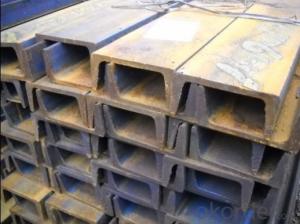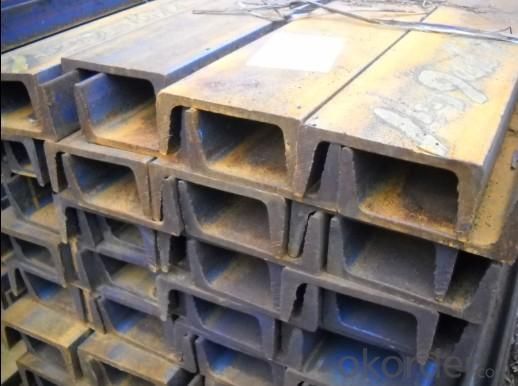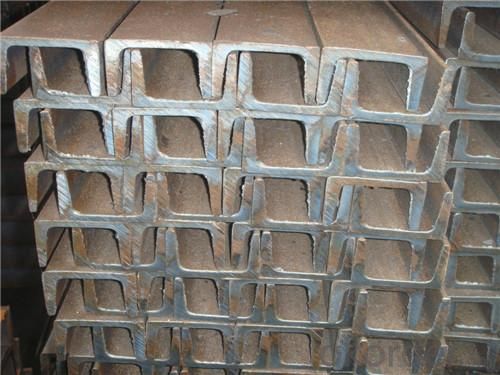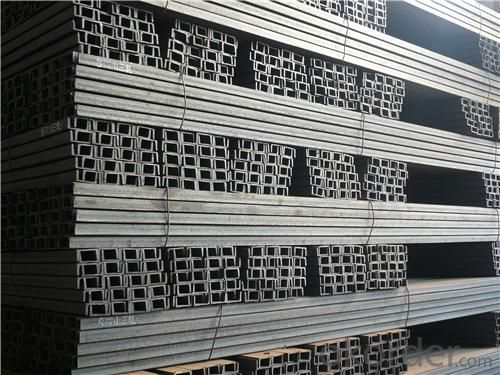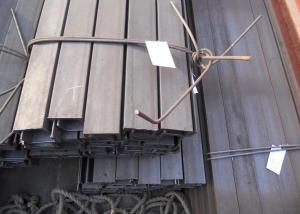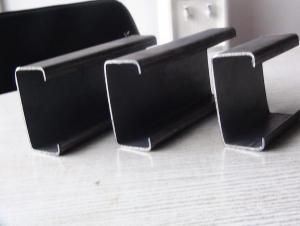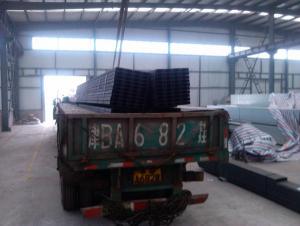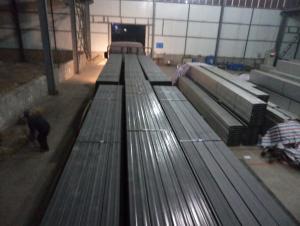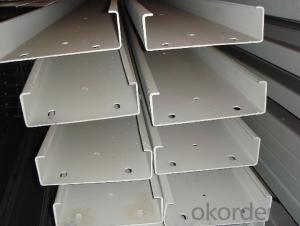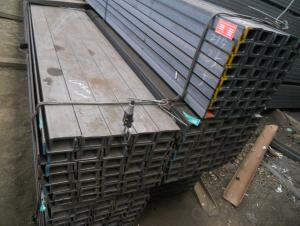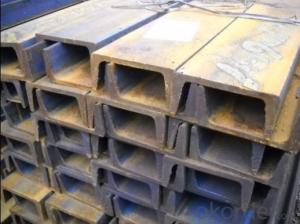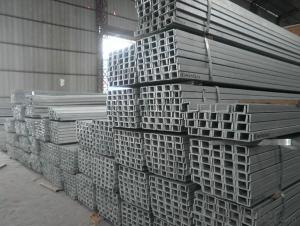80*45*6.0mm JIS U CHANNEL for CONSTRUCTION
- Loading Port:
- Tianjin
- Payment Terms:
- TT OR LC
- Min Order Qty:
- 25 m.t.
- Supply Capability:
- 10000 m.t./month
OKorder Service Pledge
OKorder Financial Service
You Might Also Like
Product Description:
Specifications of JIS Channel:
1. We are definitely speciallizing in manufacturing and supplying channel steel as per japanese standard, which is characterised with high mechanical strength and competitive prices.
2. The sections in details are as followings in the table-1
JIS CHANNEL | Standard h | Sectional b | Dimension s | t | Mass: Kg/m |
| (mm) | (mm) | (mm) | (mm) |
|
50x25 | 50 | 25 | 3.0 | 6.00 | 2.37 |
75X40 | 75 | 40 | 3.8 | 7.00 | 5.30 |
75X40 | 75 | 40 | 4.0 | 7.00 | 5.60 |
75X40 | 75 | 40 | 4.5 | 7.00 | 5.85 |
75X40 | 75 | 40 | 5.0 | 7.00 | 6.92 |
|
|
|
|
|
|
100X50 | 100 | 50 | 3.8 | 6.00 | 7.30 |
100X50 | 100 | 50 | 4.2 | 6.00 | 8.03 |
100X50 | 100 | 50 | 4.5 | 7.50 | 8.97 |
100X50 | 100 | 50 | 5.0 | 7.50 | 9.36 |
|
|
|
|
|
|
125X65 | 125 | 65 | 5.2 | 6.80 | 11.66 |
125X65 | 125 | 65 | 5.3 | 6.80 | 12.17 |
125X65 | 125 | 65 | 5.5 | 8.00 | 12.91 |
125X65 | 125 | 65 | 6.0 | 8.00 | 13.40 |
|
|
|
|
|
|
150x75 | 150 | 75 | 5.5 | 7.30 | 14.66 |
150x75 | 150 | 75 | 5.7 | 10.00 | 16.71 |
150x75 | 150 | 75 | 6.0 | 10.00 | 17.90 |
150x75 | 150 | 75 | 6.5 | 10.00 | 18.60 |
150x75 | 150 | 75 | 6.5 | 10.00 | 24.00 |
|
|
|
|
|
|
200X80 | 200 | 80 | 7.5 | 11.00 | 24.60 |
Table-1
3. The mechanical property of JIS Channel in the table-2:
Grade | Yield Strength,N/mm² | Extension Strength N/mm² | |||
Thickness of Steel,mm | |||||
≦16 | >16-≦40 | >40-≦100 | >100 | ||
SS330 | ≧205 | ≧195 | ≧175 | ≧165 | 330-430 |
SS400 | ≧245 | ≧235 | ≧215 | ≧205 | 400-510 |
SS490 | ≧285 | ≧275 | ≧255 | ≧245 | 490-610 |
SS540 | ≧400 | ≧390 | - | - | ≧540 |
Table-2
4. The chemical composition of JIS Channel in the table-3
Grade | Element(%) | |||
C | Mn | P | S | |
SS330 | -- | -- | ≦0.050 | ≦0.050 |
SS400 | ||||
SS490 | ||||
SS540 | ≦0.30 | ≦1.60 | ≦0.040 | ≦0.040 |
Table-3
Usage of JIS Channel:
1.The JIS channel can be devided into two kinds, namely common channel steel and light channel steel. The sizes of hot rolled common channel steel range from 5# to 40#. Meanwhile, the channel steel can be divided into cold forming sectional equal channel steel, cold forming sectional unequal channel steel, cold forming inner edge channel steel and outer edge channel steel.
2.The JIS channel is usually used for arch-itechtural structure, and they could be welded in order to support or hang a vari-ety of facilities. They are also usually used in combination with I beam. The channel steel with sizes under 14# is usually applied to construction engineering, as purline, while the channel steel with sizes above 16# is more likely to be used in building vehicle chassis structure and mechanical structure. Furthermore, the channel steel in sizes above 30# are target at building bridge structure, as tension bar.
3.In a word, the channel steel must possess perfect welding property, riveting property and mechanical property and so on.
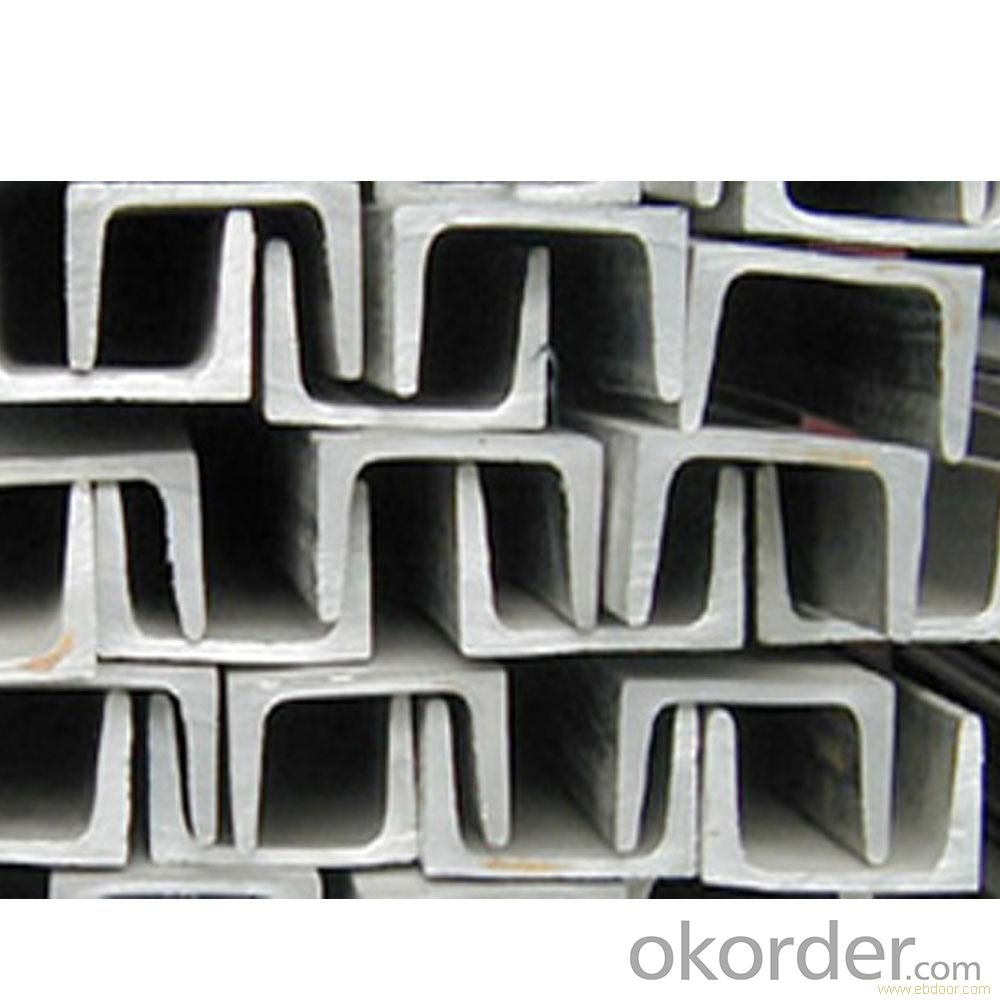
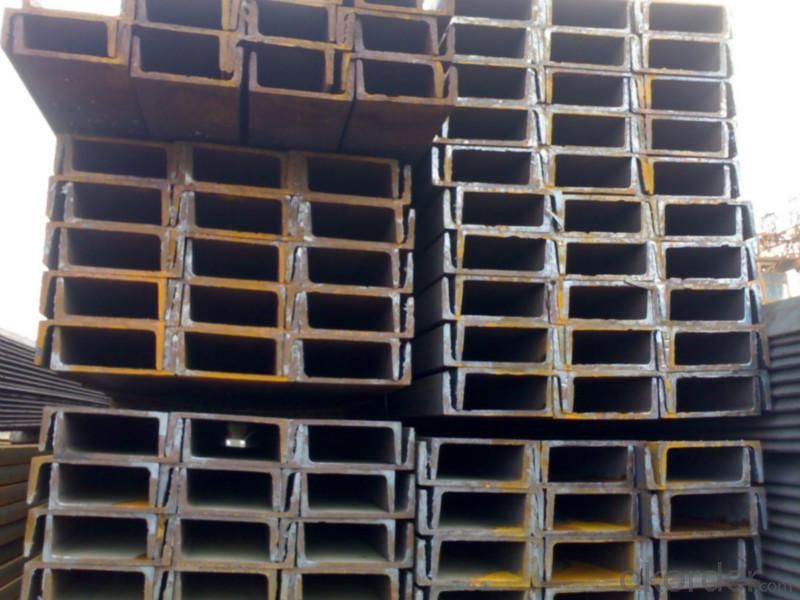
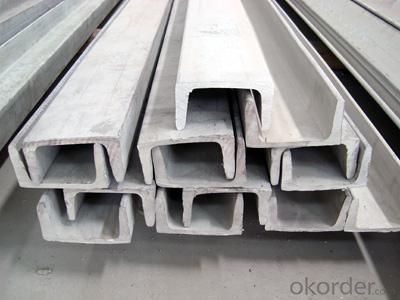
- Q: Are steel channels suitable for modular partition systems?
- Modular partition systems benefit greatly from the suitability of steel channels. The construction industry commonly employs steel channels for their robustness and endurance. They offer exceptional support and stability for modular partition systems, ensuring the partitions remain secure and capable of withstanding weight and pressure. The utilization of steel channels in modular partition systems also allows for adaptability and effortless installation. Steel channels can be easily cut and shaped to fit the desired dimensions and specifications of the partition system. This facilitates convenient customization of the layout and design to meet specific requirements. Furthermore, steel channels provide a high level of fire resistance, a critical factor in guaranteeing occupant safety. In the event of a fire, steel channels help prevent the spread of flames and smoke, providing valuable time for evacuation and minimizing damage. Additionally, steel channels exhibit resistance to corrosion, rendering them suitable for use in various environments, including high humidity areas like kitchens and bathrooms. They also require minimal maintenance, making them a practical choice over time. To summarize, steel channels present an outstanding option for modular partition systems due to their strength, durability, flexibility, fire resistance, and corrosion resistance. They establish a stable foundation for secure and long-lasting partitions, making them a trustworthy choice for a wide range of applications.
- Q: Are steel channels suitable for high-rise buildings?
- Yes, steel channels are suitable for high-rise buildings. Steel channels, also known as C-channels or U-channels, are commonly used as structural elements in high-rise construction due to their strength and versatility. Steel channels provide excellent load-bearing capacity and structural stability, making them ideal for supporting the weight of multi-story buildings. They can withstand heavy vertical loads, allowing for efficient vertical load distribution throughout the building. Additionally, steel channels are known for their resistance to bending and torsion, ensuring the structural integrity of high-rise buildings, even under extreme conditions such as earthquakes or strong winds. Furthermore, steel channels can be easily fabricated and installed, facilitating the construction process. They are available in various sizes and shapes, allowing for customized designs that suit the specific requirements of high-rise buildings. Steel channels can also be easily connected to other structural elements, such as beams or columns, creating a strong and durable framework for the entire building. Moreover, steel channels have a high strength-to-weight ratio, meaning they can provide significant structural support while keeping the overall weight of the building relatively low. This is particularly advantageous for high-rise buildings, as it reduces the total load on the foundation and lowers construction costs. Furthermore, the use of steel channels allows for flexible and adaptable designs, enabling architects and engineers to create innovative and efficient high-rise structures. In conclusion, steel channels are highly suitable for high-rise buildings due to their strength, structural stability, ease of fabrication and installation, as well as their ability to withstand extreme conditions. Their versatility and efficiency make them a preferred choice for constructing safe, durable, and aesthetically pleasing high-rise buildings.
- Q: What are the common design considerations for steel channels?
- When designing steel channels, there are several common considerations that need to be taken into account. These considerations include the following: 1. Load capacity: One of the primary design considerations for steel channels is their load-bearing capacity. The channel must be able to support the applied loads without experiencing excessive deflection or failure. This involves calculating the maximum expected loads and selecting a channel size and material that can safely carry these loads. 2. Material selection: Steel channels are available in various materials, including carbon steel and stainless steel. The material selection depends on factors such as the required strength, corrosion resistance, and cost. Different steel grades have different mechanical properties, and the appropriate material must be chosen based on the specific application. 3. Structural stability: Steel channels must possess adequate structural stability to resist buckling or collapsing under the applied loads. The design should consider the channel's length, support conditions, and the potential for lateral torsional buckling. By analyzing these factors, appropriate design measures can be taken to ensure the stability of the channel. 4. Connection design: Another important consideration is the design of the connections between steel channels and other structural elements. The connections must be designed to transfer loads effectively and securely, ensuring the overall structural integrity of the system. Factors such as joint type, fastener selection, and weld design need to be considered for proper connection design. 5. Fire resistance: In certain applications, fire resistance is a critical consideration for steel channels. The design should account for the required fire rating by incorporating appropriate fire protection measures, such as intumescent coatings or fire-resistant insulation materials. 6. Manufacturing constraints: The design must also take into consideration the manufacturing constraints involved in producing steel channels. This includes considerations such as standard sizes, manufacturing tolerances, and availability of specific profiles. By working within these constraints, the design can be optimized for ease of production and cost-effectiveness. In conclusion, when designing steel channels, it is crucial to consider factors such as load capacity, material selection, structural stability, connection design, fire resistance, and manufacturing constraints. By addressing these considerations, engineers can develop safe and efficient designs for steel channels that meet the specific requirements of the intended application.
- Q: What is the weight of a steel channel?
- The weight of a steel channel can vary depending on its dimensions and size. To determine the weight, you need to know the specific measurements and consult a steel channel weight chart or use a formula to calculate it.
- Q: The top of the elevator shaft is not pre buried hook, and now to add channel, in the channel to do hook, elevator Ii Michihiro 2500, asking the hook bearing 3 tons, the need for large channel, detailed explanation
- 2 28 channel steel or 2 25 steel
- Q: What are the different methods of corrosion protection for steel channels?
- There are several methods of corrosion protection for steel channels, including coating with paints or protective films, galvanizing, using sacrificial anodes, applying anti-corrosion primers, and utilizing cathodic protection.
- Q: How do steel channels contribute to the overall efficiency of a building?
- Steel channels contribute to the overall efficiency of a building in several ways. Firstly, they provide structural support, enhancing the strength and stability of the building. This allows for the construction of taller and larger structures, maximizing the use of space. Additionally, steel channels can be used to create open floor plans, allowing for flexible and versatile layouts. Moreover, steel channels are lightweight yet durable, making them easy to transport and install, reducing construction time and costs. Lastly, steel channels have high resistance to fire, corrosion, and pests, ensuring the long-term durability and safety of the building.
- Q: What is the weight per foot of various steel channel sizes?
- The weight of various steel channel sizes per foot can differ depending on the specific dimensions and thickness of the channel. Steel channels are typically identified by their depth, width, and weight per foot. For instance, a steel channel with a depth of 6 inches and a weight of 8.2 pounds per foot will have an approximate weight of 8.2 pounds per linear foot. Similarly, a steel channel with a depth of 10 inches and a weight of 15.3 pounds per foot will have an approximate weight of 15.3 pounds per linear foot. It is worth noting that these weights are approximate and may slightly vary based on the specific manufacturing process and tolerances. Additionally, different steel alloys or grades may have slightly different weights per foot. Therefore, it is always advisable to refer to the manufacturer's specifications or reference tables for the precise weight per foot of a specific steel channel size.
- Q: The two floor is made of channel steel barrier, but also want to do a toilet, just sitting and washbasin, so that the bathroom floor tiles can be it? What special treatment do you need? Ask designer friends for advice
- It is best not to do the toilet (for short periods of time can be), a long time after their own great wall tiles falling force, the board will damp, future risks are great (unless you do a few times waterproof layer and a reinforcement layer, but the price is too high, you can consider the use of red brick walls)
- Q: How do steel channels perform under cyclic loading?
- Steel channels generally perform well under cyclic loading due to their inherent strength and durability. The unique shape of steel channels, with their flanges and web, provides structural stability and resistance to bending, shearing, and torsion forces. This makes them particularly suitable for applications where cyclic loading is present, such as in bridges, industrial buildings, and machinery. Under cyclic loading, steel channels exhibit a high fatigue strength, meaning they can withstand repeated loading and unloading cycles without significant deformation or failure. This is mainly due to the material properties of steel, which has a high elasticity and toughness. Steel channels also have a high resistance to corrosion, which further enhances their performance under cyclic loading conditions. Moreover, steel channels can be designed with specific dimensions and cross-sections to optimize their performance under cyclic loading. Engineers can calculate the required size and shape of the channel, taking into account factors such as the anticipated cyclic loading magnitude and frequency, as well as the material properties of the steel being used. This ensures that the steel channel can effectively distribute and withstand the cyclic loads, minimizing the risk of fatigue failure. However, it is important to note that the performance of steel channels under cyclic loading can be influenced by various factors, including the quality of the steel, the design and manufacturing process, and the installation and maintenance practices. Therefore, proper material selection, design considerations, and regular inspections are necessary to ensure the long-term performance and safety of steel channels under cyclic loading.
Send your message to us
80*45*6.0mm JIS U CHANNEL for CONSTRUCTION
- Loading Port:
- Tianjin
- Payment Terms:
- TT OR LC
- Min Order Qty:
- 25 m.t.
- Supply Capability:
- 10000 m.t./month
OKorder Service Pledge
OKorder Financial Service
Similar products
Hot products
Hot Searches
Related keywords
